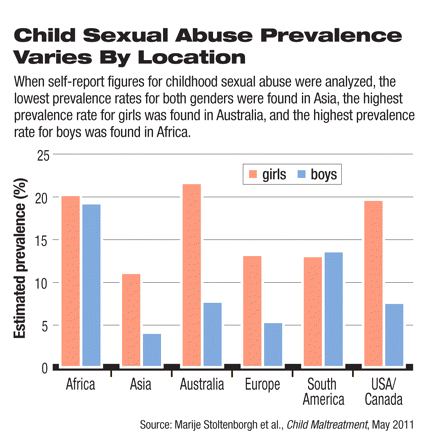Fog Surrounding Child Sex Abuse Prevalence Begins to Clear
Abstract
Although sexual abuse of children is considered egregious behavior and is known to trigger or contribute to a number of psychiatric disorders, its prevalence throughout the world has been far from clear. Estimated prevalence rates have ranged from as low as 0.1 percent up to 71 percent.
Now Dutch scientists report global prevalence figures for child sexual abuse that they believe are the most credible to date because they are derived from a meta-analysis of 217 published studies between 1980 and 2008, more than 300 samples, and nearly 10 million participants.
They determined that the rates are 12.7 percent for self-reported childhood sexual abuse and 0.4 percent for childhood sexual abuse reported by health professionals—that is, a rate of 127 per 1,000 children for the former category of reports versus a rate of 4 per 1,000 children for the latter.
The researchers said that they expected the rate for self-reported abuse to be somewhat higher than that for professionally reported abuse because of different methods used in the various studies included in their analysis. For example, most of the self-report studies they analyzed defined childhood sexual abuse as an experience that occurred during a person's first 18 years of life, whereas some of the studies using data from health professionals focused on child sexual abuse as an experience of the prior year only.
Nonetheless, the gap between the two types of prevalence rates was much larger than they expected, the lead investigator—Marije Stoltenborgh—told Psychiatric News. Stoltenborgh is a doctoral candidate at the Center for Child and Family Studies at Leiden University in the Netherlands.
But whether 12.7 percent, 0.4 percent, or somewhere in between, the prevalence statistic demonstrates that childhood sexual abuse is a global phenomenon "affecting the lives of millions of children," Stoltenborgh and her coworkers maintained in their paper, which was published in the May Child Maltreatment, the journal of the American Professional Society on the Abuse of Children.
This message, they believe, should remind the 194 countries that have ratified the United Nations' Convention on the Rights of the Child that they should be investing more time, energy, and money into preventing child sexual abuse.
The researchers noted that the global prevalence of sexual abuse is greater among girls than boys. The explanation for this finding, they wrote, is either because girls are actually more abused than boys, or that girls are more willing to report having been sexually abused, or both.

Also, the researchers found that the prevalence rates of childhood sexual abuse varied by country. The lowest rates for both boys and girls were found in Asia, the highest rate for girls was found in Australia, and the highest rate for boys was found in Africa. The reasons for these differences are unclear, they stated, although they did speculate on possible causes. For instance, the high prevalence among African boys might be partially due to cultural factors, such as initiation rites encouraging adolescents to have sex with older individuals.
The study was funded by the Netherlands Organization for Scientific Research.
An abstract of "A Global Perspective on Child Sexual Abuse: Meta-Analysis of Prevalence Around the World" is posted at <http://cmx.sagepub.com/content/16/2/79.abstract>.



